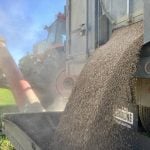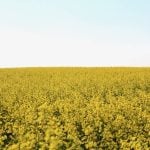
dog-strangling-vine-pestpatrol
An infestation along an old rail line and a field border.
Photo: Supplied
new-growth-dog-strangling-vine-pestpatrol
New spring growth of dog strangling vine (DSV) from established roots.
Photo: Supplied
flowers-seedpods-pestpatrol
The purple “star-shaped” flowers and “banana-shaped” seedpods.
Photo: Supplied
DSV_Eragon-LQ-pestpatrol
An unsprayed DSV plant (left) compared to one sprayed with Eragon LQ (right) seven days previous.
Photo: Supplied
DSV_blackhawk-pestpatrol
An unsprayed DSV plant (left) compared to one sprayed with Blackhawk (right) seven days previous.
Photo: Supplied
DSV_total-wipeout-pestpatrol
An unsprayed DSV plant (left) compared to one sprayed with Total Wipeout (right) seven days previous.
Photo: Supplied
Q: I’m seeing a weed called dog strangling vine along roadsides, in woodlots and creeping into agricultural fields. It seems quite invasive. How do I get rid of it?
A: Your suspicions are correct. Dog strangling vine is invasive and is listed as a noxious weed under the Ontario Weed Control Act, and regulated as “restricted” under Ontario’s Invasive Species Act. If you see this weed growing, contact your municipal weed inspector. Aggressively growing perennial weeds like dog strangling vine require multiple control strategies that can be used in all habitats where this species is found. Here are some of the strategies that are being investigated in Ontario:
Read Also

Sensing the soil: Root cell research finds ‘stress hormone’
Research into how root cells react to soil stressors could help plants better adapt to changes in their climate.
Bio-control: A research group led by Agriculture and Agri-food Canada released Hypena opulenta caterpillars around Ottawa and Toronto in 2014. These caterpillars will feed on dog strangling vine. Although it will take several years to see if this is an effective bio-control method, there have been promising observations so far.
Herbicides: The use of certain herbicides may be restricted depending on where this weed is found (e.g. a roadside versus a non-agricultural private lot). Nancy Cain, an independent vegetation management researcher, has evaluated different herbicide programs along roadsides. The herbicide Arsenal Powerline, which lists dog strangling vine on its label, has been the most effective option in her trials.
Although glyphosate can be effective when applied multiple times and at high rates, it also removes desirable vegetation that often inhibit the germination and emergence of new seedlings.
The University of Guelph has recently begun screening herbicides to identify those which could be used by farmers and non-farm landowners. So far, Eragon LQ and Blackhawk are agricultural herbicides that have shown the greatest activity on dog strangling vine seedlings. A product called Total Wipeout, which contains ammonium salt of fatty acids (five per cent), has been the most effective Class 6 herbicide that landowners could purchase at a garden centre or hardware store. Unfortunately Total Wipeout is non-selective and only controls top growth, so it is better suited to control newly emerged seedlings instead of established perennial weeds that will easily grow back.
Mechanical control: Mowing several times throughout the season can be effective at reducing seed production and over time lowering the entire population. However, dog strangling vine often grows most densely in terrains where it is not easy or possible to use machinery.
Have a question you want answered? Hashtag #PestPatrol on Twitter to @cowbrough or email Mike at [email protected].

























